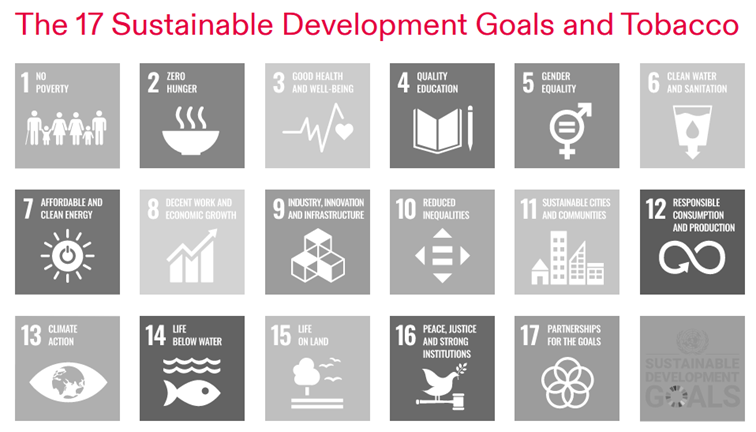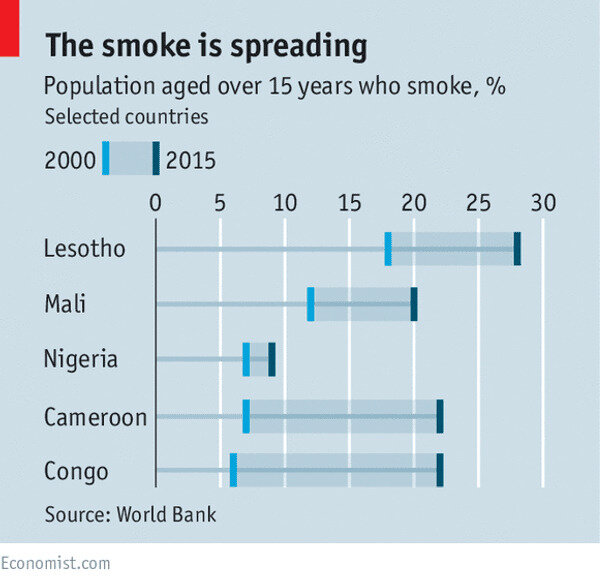- Exchange and Networking
- Knowledge and Learning
- Advocacy
- Our topics
By Luciano Ruggia
Tobacco consumption and production has a negative impact on each of the 17 Sustainable Development Goals (SDGs). Tobacco is consumed by more than 1.1 billion people on the planet, and it is estimated that it directly kills eight million people every year and affects the health of hundreds of million more. But those are just the end effects of the most harmful industry of all, and the tobacco problem should not be addressed only for its negative public health impact. The whole supply chain of tobacco production has a disastrous impact on the life of people in tobacco-growing countries, on the environment and on human rights. In fact, there is not a single SDG that is not negatively impacted by tobacco.

Tobacco production and consumption is a global business. Tobacco is grown mostly in tropical countries, and is based on a farming model that leads to the exploitation of farmers to the benefit of large national exporting companies. Large-scale farming also causes deforestation, doubled by the need for wood to cure the tobacco leaves and by the intensive use of water and chemical products (pesticides, fungicides). The leaves are then exported to developed countries where cigarettes are produced, concentrating the added-value benefits there. Then cigarettes are sold everywhere, even back to the countries where tobacco was grown, causing health and more environmental problems there. Facing a reduction of tobacco consumption in rich countries, big tobacco is also successfully increasing its marketing efforts in low- and middle-income countries (LMICs).
Smoking is spreading especially in African countries. According to data collected by the World Health Organization (WHO), smoking rates have increased in only 27 countries over the past 15 years; 17 are in Africa. Congo-Brazzaville has witnessed the most staggering spike: 22% of its people admitted to smoking regularly in 2015, up from 6% in 2000 (see chart). Nearly half of Congolese men now light up. The share of smokers in Cameroon more than doubled in the same period as well, from 7% to 22% (The Economist, 2016).

In September 2015, United Nations Member States adopted the 2030 Agenda for Sustainable Development, making a commitment to achieve 17 Sustainable Development Goals (SDGs), ranging from eradicating extreme poverty to combating climate change, and promoting peaceful and inclusive societies. For the first time, a specific target on tobacco control was included (Target 3.a), positioning implementation of the World Health Organization Framework Convention on Tobacco Control (WHO FCTC) as key to sustainable development. This was done in recognition not only of the tremendous health toll of tobacco use, but also of the social, economic and environmental impacts of tobacco use and production on individuals, families, communities and countries. The WHO FCTC is an authentic accelerator for the SDGs (UNDP and WHO FCTC Secretariat, 2017). Switzerland has so far failed to ratify the WHO FCTC, but is committed to the SDG framework and should therefore also try to promote the achievement of Target 3.a too.
The whole supply chain of tobacco production has a disastrous impact on the life of people in tobacco-growing countries, on the environment and on human rights.
Tobacco control organisations are already very conscious of the negative tobacco impact on all SDGs and have integrated the SDG perspective into their advocacy approaches. In 2019, STOP already linked systematically every SDG to tobacco with a fact sheet (STOP, 2019). However, this analysis needs to be further developed and its results should be brought outside the circle of tobacco-control organisations. The Swiss Association for Tobacco Control attempted to dig deeper by initiating a series of analyses of the impact on each SDG. This series was started in 2021 and is progressively adding new SDG texts, with a goal of having them all online in four languages by the end of 2022 (AT Schweiz, 2021). The aim of this MMS Bulletin special issue is also to stimulate more attention to this problem among global health organisations and Swiss NGOs.
Swiss organisations play an important role in global health. Geneva is considered to be the global health capital, with many international organisations based there. Switzerland has a strong humanitarian and global health cooperation tradition embodied by many institutions, whether universities or NGOs. The country has always been active in improving the health of poor populations in many countries. For many years the special focus in global health cooperation was on infectious diseases, some specifically tropical, like malaria, other having specific impact in LMIC, like HIV/AIDS. Nowadays, attention has been moving towards a stronger engagement to fight non-communicable diseases (NCDs).
The rise of NCDs in many countries is linked to rapidly changing lifestyle conditions. But if intervention has been focused so far on the consequences (i.e. how to improve treatments for cancer, diabetes, cardiovascular disease and so on), attention to prevention has been lacking. Smoking is one of the most important, if not “the” most important, risk factor for many NCDs. However, we were not able to identify in any health strategy of a Swiss institution working on global health, whether the SDC or any NGO, the smallest mention of specific measures for tobacco prevention and control.
The aim of this MMS Bulletin special issue is also to stimulate more attention to this problem among global health organisations and Swiss NGOs.
To be fair, in its Global Programme Health (Programme Framework 2021–24), the SDC mentions NCDs extensively, but tobacco only once. Regarding prevention, the programme only focuses on the need to improve health literacy, thus education of populations (Swiss Agency for Development and Cooperation - SDC, 2021). Prevention, especially for an addiction like tobacco consumption, should be much more than that and should include many aspects, first and foremost the support for structural prevention.
However, Switzerland also plays a much darker role, as it is also one of the world leaders in tobacco production and trade, with important international tobacco companies like Philipp Morris International (PMI), British American Tobacco (BAT) and Japan Tobacco International (JTI) managing key worldwide operations from our country. Many factors played a role in their establishment in Switzerland, but fiscal advantages, very weak regulation and a tobacco-friendly political environment certainly played deciding roles (RTS, 2018).

Switzerland often promotes the fact that it exports its delicious chocolate and prestigious watches to the rest of the world. Yet there is another Swiss product that is just as successful, but far less vaunted: cigarettes. In 2016, Switzerland produced 34.6 billion cigarettes – nearly two billion packets. Some 25% were sold on the domestic market. Nearly 75% were exported, providing enough cigarettes for over four million people to smoke a pack a day over the year. Swiss cigarettes exported to many African or Middle East countries come with a Swiss label: they carry a SICPA stamp, the Swiss certification and authentication body. However, a 2019 enquiry based on laboratory analysis gave a clear result: the cigarettes produced on Swiss soil and sold in Morocco are much stronger, more addictive, and more toxic than those sold in Switzerland or France (Maurisse, Marie, 2019).
Swiss foreign policy aims to promote the health of populations through aid provided by the Swiss Agency for Development and Cooperation (SDC), while at the same time promoting and protecting industrial and financial interests, including the tobacco companies. This is, at the least, a worrying contradiction.
However, a 2019 enquiry based on laboratory analysis gave a clear result: the cigarettes produced on Swiss soil and sold in Morocco are much stronger, more addictive, and more toxic than those sold in Switzerland or France.
For small or large NGOs working in LMIC, fundraising efforts are always a struggle. Accepting or applying for funding coming from institutions linked to the tobacco companies could be a strong temptation. Nobody would consider today accepting money from an armament company to support humanitarian intervention is a conflict zone. When the total harm of a business is negative, as is very much the case for the tobacco companies, how can we accept their money and pretend to remain ethically uncompromised?
The tobacco companies is giving away money not because they want a better world, but to foster their own interests. With their so-called “charitable contributions” or their “foundations”, tobacco companies try to sing the song of responsibility and compassion, but the charitable foundations created by those industries are nothing more than front organisations established to whitewash the terrible public image of the tobacco companies. There is an even deeper and darker tune to the tobacco companies’ song – direct corruption of African governments, as it was recently revealed (Tabacco Tactics, 2021).
Private sector meddling into the SDGs has already been questioned and some industries clearly are hijacking the SDGs for their own benefit (Absagen, Marie-Louise et al., 2018). Front groups created by the tobacco companies are clearly exploiting an SDG rhetoric only to hide their true purposes. This is the case with Eliminating Child Labour in Tobacco-growing Foundation (ECLT). The web page gives the appearance of a nice organisation active in the elimination of child labour in tobacco farming. SDGs images are prominently displayed on the web page, as they are pictures of happy children in happy schools. It takes some digging in the website to discover that the ECLT is entirely and uniquely financed by the tobacco companies. The foundation’s office in Geneva is housed in a building hosting attorneys and financial companies’ offices in a prestigious location close to Lac Leman (Lake Geneva). The number of children forced into labour is not decreasing and has increased in 2020 by over 8 million – reaching 160 million children worldwide (WHO FCTC, 2021). The action of the ECLT is not improving anything, but the industry, thanks to ECLT, tries to bypass Art. 5.3 FCTC and thus can successfully infiltrate high-level discussions in global health.
Any NGO that aims to work within the SDG perspective should integrate in its strategy the total rejection of any cooperation with the tobacco companies. By accepting money, directly or through front groups linked to big tobacco, an NGO compromises its reputation, even when it claims that its work remains independent. The tobacco companies is the problem, but it’s never part of the solution.